Related Research Articles

The hammered dulcimer is a percussion-stringed instrument which consists of strings typically stretched over a trapezoidal resonant sound board. The hammered dulcimer is set before the musician, who in more traditional styles may sit cross-legged on the floor, or in a more modern style may stand or sit at a wooden support with legs. The player holds a small spoon-shaped mallet hammer in each hand to strike the strings. The Graeco-Roman word dulcimer derives from the Latin dulcis (sweet) and the Greek melos (song). The dulcimer, in which the strings are beaten with small hammers, originated from the psaltery, in which the strings are plucked.
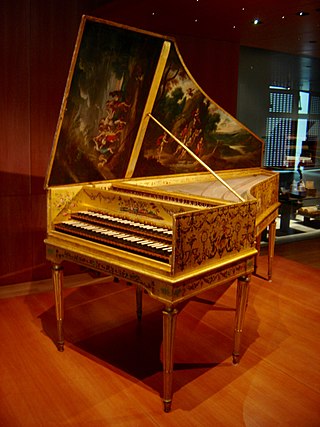
A harpsichord is a musical instrument played by means of a keyboard. This activates a row of levers that turn a trigger mechanism that plucks one or more strings with a small plectrum made from quill or plastic. The strings are under tension on a soundboard, which is mounted in a wooden case; the soundboard amplifies the vibrations from the strings so that the listeners can hear it. Like a pipe organ, a harpsichord may have more than one keyboard manual, and even a pedal board. Harpsichords may also have stop buttons which add or remove additional octaves. Some harpsichords may have a buff stop, which brings a strip of buff leather or other material in contact with the strings, muting their sound to simulate the sound of a plucked lute.

A harmonic series is the sequence of harmonics, musical tones, or pure tones whose frequency is an integer multiple of a fundamental frequency.

In music, there are two common meanings for tuning:

The piano is a keyboard instrument with strings struck by wooden hammers coated with a softer material. It is played using its keyboard, which is a row of keys touched by the performer with the fingers and thumbs of both hands, causing the hammers to strike the strings. It was invented in Italy by Bartolomeo Cristofori around the year 1700.
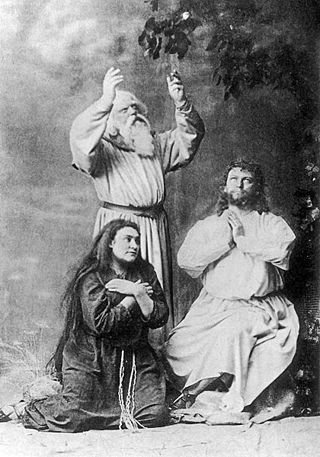
Parsifal is an opera or a music drama in three acts by the German composer Richard Wagner and his last composition. Wagner's own libretto for the work is loosely based on the 13th-century Middle High German epic poem Parzival of the Minnesänger Wolfram von Eschenbach, recounting the story of the Arthurian knight Parzival (Percival) and his quest for the Holy Grail.
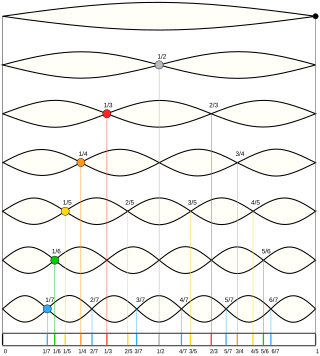
A harmonic is a wave with a frequency that is a positive integer multiple of the fundamental frequency, the frequency of the original periodic signal, such as a sinusoidal wave. The original signal is also called the 1st harmonic, the other harmonics are known as higher harmonics. As all harmonics are periodic at the fundamental frequency, the sum of harmonics is also periodic at that frequency. The set of harmonics forms a harmonic series.

An overtone is any resonant frequency above the fundamental frequency of a sound. In other words, overtones are all pitches higher than the lowest pitch within an individual sound; the fundamental is the lowest pitch. While the fundamental is usually heard most prominently, overtones are actually present in any pitch except a true sine wave. The relative volume or amplitude of various overtone partials is one of the key identifying features of timbre, or the individual characteristic of a sound.

Orchestration is the study or practice of writing music for an orchestra or of adapting music composed for another medium for an orchestra. Also called "instrumentation", orchestration is the assignment of different instruments to play the different parts of a musical work. For example, a work for solo piano could be adapted and orchestrated so that an orchestra could perform the piece, or a concert band piece could be orchestrated for a symphony orchestra.

String instruments, stringed instruments, or chordophones are musical instruments that produce sound from vibrating strings when a performer plays or sounds the strings in some manner.
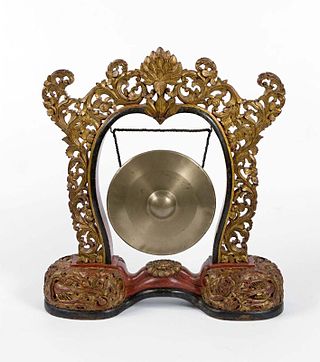
A gong is a percussion instrument originating in East Asia and Southeast Asia. Gongs are a flat, circular metal disc that is typically struck with a mallet. They can be small or large in size, and tuned or can require tuning.

The crwth is a bowed lyre, a type of stringed instrument, associated particularly with Welsh music, now archaic but once widely played in Europe. Four historical examples have survived and are to be found in St Fagans National Museum of History (Cardiff); National Library of Wales (Aberystwyth); Warrington Museum & Art Gallery; and the Museum of Fine Arts, Boston (US).
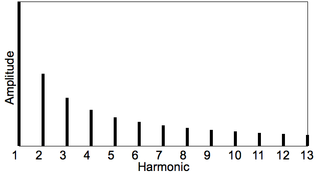
In music, inharmonicity is the degree to which the frequencies of overtones depart from whole multiples of the fundamental frequency.

Aliquot stringing is the use of extra, un-struck strings in the piano for the purpose of enriching the tone. Aliquot systems use an additional string in each note of the top three piano octaves. This string is positioned slightly above the other three strings so that it is not struck by the hammer. Whenever the hammer strikes the three conventional strings, the aliquot string vibrates sympathetically. Aliquot stringing broadens the vibrational energy throughout the instrument, and creates an unusually complex and colorful tone.

Piano tuning is the act of adjusting the tension of the strings of an acoustic piano so that the musical intervals between strings are in tune. The meaning of the term 'in tune', in the context of piano tuning, is not simply a particular fixed set of pitches. Fine piano tuning requires an assessment of the vibration interaction among notes, which is different for every piano, thus in practice requiring slightly different pitches from any theoretical standard. Pianos are usually tuned to a modified version of the system called equal temperament.

The 3rd bridge is an extended playing technique used on the electric guitar and other string instruments that allows a musician to produce distinctive timbres and overtones that are unavailable on a conventional string instrument with two bridges. The timbre created with this technique is close to that of gamelan instruments like the bonang and similar Indonesian types of pitched gongs.
A third bridge can be devised by inserting a rigid preparation object between the strings and the body or neck of the instrument, effectively dividing the string into distinct vibrating segments.

Steingraeber & Söhne is a piano manufacturer in Bayreuth, Germany.

A tromba marina, marine trumpet or nuns' fiddle, is a triangular bowed string instrument used in medieval and Renaissance Europe that was highly popular in the 15th century in England and survived into the 18th century. The tromba marina consists of a body and neck in the shape of a truncated cone resting on a triangular base. It is usually four to seven feet long, and is a monochord. It is played without stopping the string, but playing natural harmonics by lightly touching the string with the thumb at nodal points. Its name comes from its trumpet like sound due to the unusual construction of the bridge, and the resemblance of its contour to the marine speaking-trumpet of the Middle Ages.
The strike tone, strike note, or tap note, of a percussion instrument when struck, is the dominant note perceived immediately by the human ear. It is also known as the prime or fundamental note. However, an analysis of the bell's frequency spectrum reveals that the fundamental only exists weakly and its dominance is a human perception of a note built up by the complex series of harmonics that are generated. The correct and accurate harmonic tuning is therefore important in creating a good strike tone.

Mechanical music technology is the use of any device, mechanism, machine or tool by a musician or composer to make or perform music; to compose, notate, play back or record songs or pieces; or to analyze or edit music. The earliest known applications of technology to music was prehistoric peoples' use of a tool to hand-drill holes in bones to make simple flutes. Ancient Egyptians developed stringed instruments, such as harps, lyres and lutes, which required making thin strings and some type of peg system for adjusting the pitch of the strings. Ancient Egyptians also used wind instruments such as double clarinets and percussion instruments such as cymbals. In Ancient Greece, instruments included the double-reed aulos and the lyre. Numerous instruments are referred to in the Bible, including the horn, pipe, lyre, harp, and bagpipe. During Biblical times, the cornet, flute, horn, organ, pipe, and trumpet were also used. During the Middle Ages, hand-written music notation was developed to write down the notes of religious Plainchant melodies; this notation enabled the Catholic church to disseminate the same chant melodies across its entire empire.
References
- This article incorporates text from a publication now in the public domain : Schlesinger, Kathleen (1911). "Parsifal bell-instrument". In Chisholm, Hugh (ed.). Encyclopædia Britannica . Vol. 20 (11th ed.). Cambridge University Press. pp. 867–868.